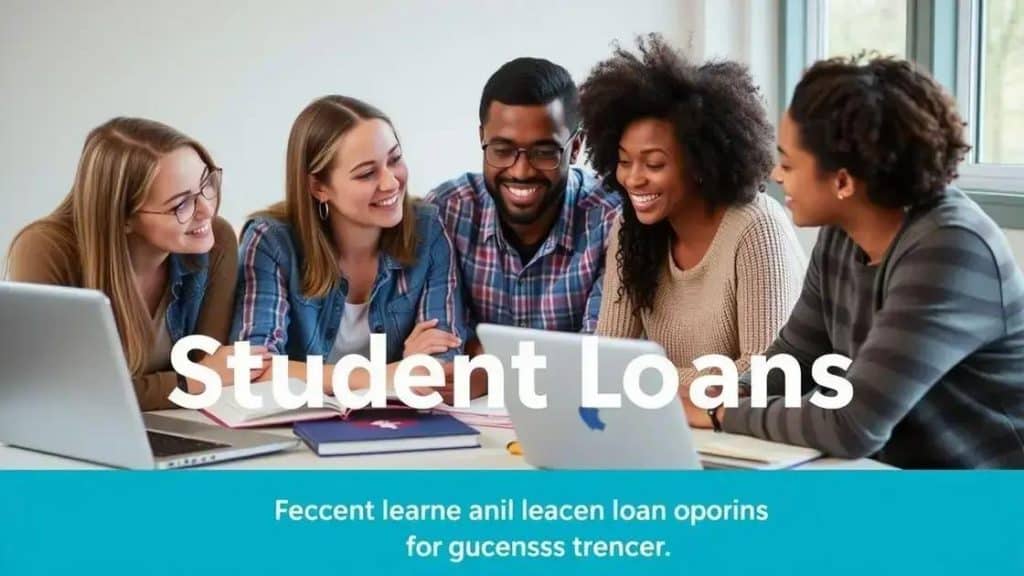Student loan forgiveness programs: discover your options

Anúncios
Student loan forgiveness programs provide financial relief by eliminating some or all loan debt for eligible borrowers, typically tied to employment in public service or education fields.
Student loan forgiveness programs are a lifeline for many graduates struggling with debt. Have you ever wondered how they could benefit you? In this article, we’ll dive into your options and guide you through the process.
Anúncios
What are student loan forgiveness programs?
Student loan forgiveness programs are designed to provide financial relief to borrowers by eliminating part or all of their loan debt. They are especially beneficial for those struggling to repay their loans due to various circumstances. Understanding how these programs work can open up opportunities for you.
How do these programs operate?
Typically, student loan forgiveness programs require borrowers to meet specific criteria, including the type of loan, employment in qualifying fields, and adherence to payment plans. Many are designed for public service workers, teachers, healthcare professionals, and those facing economic hardship.
Anúncios
Key features of student loan forgiveness programs:
- Eligibility requires consistent payments over a certain period.
- Jobs in public service can lead to significant debt relief.
- Different programs target various professions and situations.
- Requirements often include having a qualifying loan type.
Additionally, some programs may offer forgiveness after making payments for ten to twenty years. This means that your dedication and service can earn you the chance to have a portion of your student loan debt forgiven. Before applying, it’s crucial to research and verify your eligibility thoroughly.
Types of forgiveness available
There are numerous options available, each tailored to different career paths and life situations. For instance, Public Service Loan Forgiveness (PSLF) is specifically for individuals working full-time in public service roles. The program forgives the remaining balance on Direct Loans after the borrower has made 120 qualifying monthly payments.
Benefits of pursuing forgiveness
Participating in a forgiveness program can dramatically change your financial situation. Rather than being weighed down by debt, you can focus on building your future. The sense of relief when your loans are forgiven can be life-changing, allowing you to invest in other aspects of your life or pursue new opportunities without the burden of student loan payments.
Eligibility criteria for forgiveness programs

Understanding the eligibility criteria for forgiveness programs is crucial for anyone looking to relieve their student loan debt. Each program has specific requirements that borrowers must meet to qualify. These criteria can often seem overwhelming, but breaking them down can make it easier to identify your options.
Common eligibility requirements
To qualify for student loan forgiveness, borrowers typically need to fulfill several key requirements. These may include the type of loan, the repayment plan you are on, and how long you have been making payments.
- Your loans must be federal student loans, not private loans.
- You need to be enrolled in a qualifying repayment plan.
- You must make a specified number of qualifying payments.
- Some programs require employment in a specific field or sector.
It’s important to note that not all repayment plans qualify for forgiveness. For example, income-driven repayment plans often count toward the necessary payments, while others may not. Additionally, if you work in public service, you have a higher chance of qualifying for specific forgiveness programs. Many jobs in education, healthcare, and government sectors come with additional considerations for loan forgiveness.
Documentation and application process
Gathering proper documentation is essential when applying for forgiveness. You’ll need to demonstrate your employment, your loan status, and your payment history. Accurate records will strengthen your application. Some programs also require you to certify your employment at regular intervals.
Understanding your loan type
Not all loans are eligible for forgiveness. Direct Loans are usually the focus of forgiveness programs. If you have other types of loans, such as Perkins Loans or FFEL Loans, you may need to consolidate them into a Direct Consolidation Loan to qualify for some forgiveness programs.
Types of student loan forgiveness options
Knowing the types of student loan forgiveness options can help borrowers make informed decisions about their loans. Each program targets specific professions or circumstances, making it important to understand what is available.
Public Service Loan Forgiveness (PSLF)
This program is aimed at individuals working in public service jobs. If you work for a government organization or a non-profit, you may qualify for PSLF. To become eligible, you must make 120 qualifying monthly payments under a qualifying repayment plan while working full-time in a qualified public service job.
Teacher Loan Forgiveness
Teachers who work in low-income schools may be eligible for this program. Depending on how long you teach and your subject area, you can receive forgiveness for up to $17,500 on your Direct or Stafford Loans. This option is beneficial for educators who want to make a difference while also addressing their student debt.
Income-Driven Repayment (IDR) Forgiveness
If you enroll in an IDR plan, you can have your remaining loan balance forgiven after making payments for 20 to 25 years, depending on the plan. Your monthly payments will be based on your income and family size, making it more manageable for many borrowers.
Perkins Loan Cancellation
For borrowers with Perkins Loans, cancellation may be possible based on your career choice. For example, if you are a teacher, nurse, or law enforcement officer, you might qualify for full or partial cancellation. Each profession has specific criteria, so it’s essential to check the details.
Exploring all these options can lead to significant financial relief for borrowers. Regardless of your path, there is likely a forgiveness program that aligns with your career goals and personal circumstances. Making an informed choice can relieve some of the burdens that come with student loans.
How to apply for student loan forgiveness programs

Applying for student loan forgiveness programs can seem daunting but breaking it down into clear steps makes it manageable. Many borrowers are unaware of the specific processes required to take advantage of these options.
Understand your eligibility
Before you begin the application process, it’s essential to know if you qualify for a forgiveness program. Different programs have distinct eligibility requirements based on factors like your job, loan type, and repayment plan. Make sure to review these before applying.
Gather required documents
Documentation is crucial for the application process. Common documents needed may include:
- Your student loan information, including loan types and balances.
- Proof of employment in a qualifying sector or position.
- Your payment history, showing eligible payments made toward your loans.
- Identification documents to verify your identity.
Having these documents ready will streamline your application and reduce the chances of delays.
Complete the application form
Most forgiveness programs require you to complete an application form. This form can often be found on the loan servicer’s website or the specific forgiveness program’s site. Be thorough and accurate when filling it out, as errors can lead to complications.
Submit your application
Once you have completed the application form, the next step is to submit it. Make sure to follow the submission guidelines carefully. This may involve submitting it online or mailing it in. Keep a copy of your application and any supporting documents for your records.
Patience is essential after submission. It can take time for your application to be reviewed. During this period, don’t hesitate to follow up with your loan servicer for updates on your application status. Staying informed can help you anticipate the next steps.
In conclusion, understanding and navigating student loan forgiveness programs can significantly ease your financial burden. By knowing the eligibility criteria, types of forgiveness options, and how to apply, you set yourself up for success. Remember to gather all necessary documents and stay engaged with your loan servicer throughout the process. With persistence and the right information, you can work towards a debt-free future.
FAQ – Frequently Asked Questions about Student Loan Forgiveness Programs
What types of student loan forgiveness programs are available?
There are various options, including Public Service Loan Forgiveness, Teacher Loan Forgiveness, and Income-Driven Repayment forgiveness.
How do I know if I qualify for a forgiveness program?
Eligibility depends on your loan type, employment in qualifying fields, and repayment plans. Check the specific requirements for each program.
What documents do I need to apply for loan forgiveness?
You typically need your loan information, employment verification, payment history, and identification documents.
How long does it take to find out if my application is approved?
The approval process can vary, but it may take several weeks to months. Stay in contact with your loan servicer for updates.





